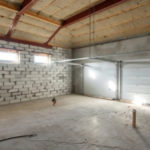An air compressor is a mechanical device that converts power from a gasoline/diesel engine or an electric motor into energy stored in pressurized air. The air pressure created can be used to handle different tasks.
Mostly, you will find air compressors at gas stations being used to refill car tires. Air compressors can also be helpful in your home garage. Having one will help you upgrade your garage in a variety of ways. It will help you in your DIY projects.
You will be able to carry out your spray painting or carpentry hobbies with at most effectiveness and efficiency.
When looking for the best air compressor home garage, do not be in a rush. You need to take your time and do thorough background research. An air compressor will help you simplify your work.
Top 10 Air Compressors for Home Garage Comparison Table
| Picture | Name | Capacity | Max Pressure | Rating (1-5) |
|---|---|---|---|---|
 | 1. Industrial Air ILA1883054 Air Compressor | 30 Gallons | 155 PSI | 4.3 |
 | 2. Ingersoll Rand SS5 5HP Air Compressor | 60 Gallons | 135 PSI | 4.3 |
 | 3. DeWalt DXCM271.COM Portable Air Compressor | 27 Gallons | 90 PSI | 4.4 |
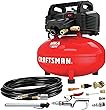 | 4. Craftsman Air Compressor | 6 Gallons | 90 PSI | 4.8 |
 | 5. California Air Tools 8010 Steel Tank Air Compressor | 8 Gallons | 120 PSI | 4.7 |
 | 6. DEWALT Pancake Air Compressor | 6 Gallons | 90 PSI | 4.7 |
 | 7. California Air Tools 10020C Ultra Quiet Air Compressor | 10 Gallons | 90 PSI | 4.4 |
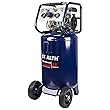 | 8. Stealth 20 Gallon Ultra Quiet Air Compressor | 20 Gallons | 150 PSI | 4.3 |
 | 9. Craftsman Air Compressor | 10 Gallons | 90 PSI | 4.6 |
 | 10. Makita MAC320Q Quiet Series Electric Air Compressor | 3 Gallons | 90 PSI | 4.8 |
Things to Consider When Looking For the Best Air Compressor For Home Garage
The Power Supply of the Compressor
When choosing an air compressor, you have to check the kind of power it runs on. It can either be electricity or gasoline. Electrically powered compressors are more popular. They run quietly as compared to their gasoline-powered counterparts.
The Capacity of Air They Can Hold
You will need to go for an air compressor that holds the air capacity that suits your requirements. There is a lot you can do with an air compressor in your home garage. You must go for a compressor whose air capacity will meet all that you are planning to do in your home garage.
Compressor Design
Compressor design is another critical factor. There are about three different designs for compressor units.
The piston-powered compressor unit is the most prevalent of all. This compressor design utilizes some cylinders. These pistons play the role of squeezing the air and transferring it to the reservoir.
The other two designs are the scroll and rotary-screw models. The best design of the three is the piston-powered design.
Air Compressor Configuration
The configuration of an air compressor puts more emphasis on its practicality. Two of the most common configurations are the horizontal tank compressors and the vertical air compressors.
Your pick will depend on where the compressor is being used. Construction sites would lean towards the horizontal compressors due to the added advantage of stability.
Vertical tanks are ideal for shops that have a squeezed space. Sitting upright ensures that space is well utilized.
Top 3 Best Air Compressors For Home Garage Reviews
1. Industrial Air ILA1883054 Air Compressor
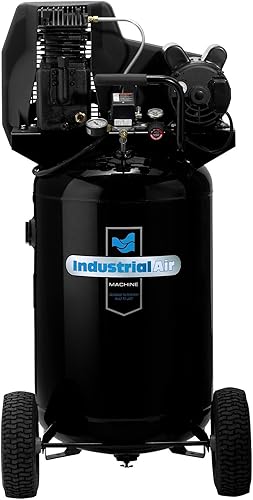
Specifications:
- Dimensions (LxWxH): 24.75 x 24.75 x 49.75 inches
- Capacity: 30-gallon tank
- Max Pressure: 155 PSI
- Warranty: 2 years
This is one of the best options for an individual looking for a sturdy air compressor that is ideal for a home garage. The Industrial Air ILA1883054 air compressor is highly reliable in terms of power and performance.
It features a twin-cylinder pump made of cast iron that makes it sturdy.
This compressor has a power capacity of 120-volts. It comes with a 1HP motor that can fill up the thirty-gallon tank to 155 PSI. It can deliver air at cubic feet per minute (CFM) of 5.7 at 90 pounds per square inch (PSI).
This compressor generates noise levels of 70 decibels that make it fit for home applications. This unit is ideal for regular use since it has oil lubrication that offers much-needed durability.
The cast iron built ensures this compressor lasts for a long time. It features a beautiful finish and operates quietly.
2. Ingersoll Rand SS5 5HP Air Compressor

Specifications:
- Dimensions (LxWxH): 24 x 30 x 73 inches
- Capacity: 60-gallon tank
- Max Pressure: 135 PSI
- Warranty: 1 year
The Ingersoll Rand SS5 5HP air compressor is preferred by most professionals and homeowners for its ease of use. It is also reliable and effective. It is ideal for DIYs as well as professionals. It offers a very stable performance.
This compressor features a 5-horsepower single-phase motor with thermal overload protection.
This compressor can be used in many applications such as nailers, impact guns, sanders, and paint sprayers. This compressor runs quietly as it produces 78 dBA.
An incredible thing about this compressor is that it delivers 15.5 CFM at 135 PSI and 18.1 CFM at 90 PSI. It is user-friendly and features components like a safety valve, regulator, pressure switch, and pressure gauge.
Many users like this compressor for its smooth and quiet operation.
3. DeWalt DXCM271.COM Portable Air Compressor
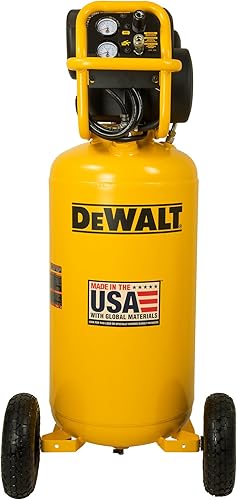
Specifications:
- Dimensions (LxWxH): 54.5 x 26.8 x 23.5 inches
- Capacity: 27-gallon tank
- Max Pressure: 90 PSI
- Warranty: 1 year
The DeWalt DXCM271.COM air compressor has a twenty-seven-gallon unit with 5.1 SCFM at 90-PSI. It makes it a very powerful and efficient air compressor.
It features a dual-purpose handle that helps one in wrapping the hose thus enhancing protection.
Using this air compressor is easy and straightforward because it features incredible extension cords and two-inch gauges.
For this reason, this air compressor can offer high performance as well as high efficiency from its couplers and top flow regulators for maximum airflow.
This compressor features a 78-dBA noise rating that means it generates minimal noise to the garage.
Frequently Asked Questions
What is a Two-Stage Air Compressor?
A two-stage air compressor involves compressing air twice. It comprises two pistons, one large for low pressure and a small one for high pressure.
One of the visible attributes is the cylinder size. A two-stage compressor has one side that is larger than the other.
It uses the following process:
- Sucking air into a cylinder.
- Compressing the trapped air in a single stroke with the first piston.
- Air is directed into the second part of the cylinder. Here it is compressed again with a high-pressure piston.
- The double pressurized air is moved into a storage tank.
How to Increase CFM on Air Compressors?
All air compressors have a CFM (Cubic Feet per Minute) rating for a certain pressure, and the tools also need a precise CFM rating to operate. Sometimes you need a higher CFM to complete your work.
So how do you increase the CFM of an air compressor? You can do this in two ways.
Decrease the Pressure to Increase CFM
Generally, a compressor takes in air which builds pressure in the cylinder. The pressure is responsible for the rate at which the air goes out with. This rate is referred to as CFM.
The power rating on the compressor is dependent on the pressure and, CFM expressed as:
Power = Pressure x Volume / TimeThe [volume/time] is the CFM. To keep the power constant, you can lower the pressure to increase the CFM.
Remember, you can’t operate the air compressor past its limit. So, to have less pressure in the tank, you need to dial down the regulator.
The air will have a slow flow into the tank hence building low pressure. It will enable you to have a high CFM. The method has a limit but will cause no damage to the compressor.
Increase CFM by Connecting Two Compressors
In the first method, you cannot have a higher CFM than the indicated limit. What happens when you need a high CFM than the maximum limit on your compressor?
This method involves combining two compressors to have a higher CFM.
Here are the steps to follow to connect two air compressors:
- Have two compressors and connect the cylinders of both compressors with two separate hoses.
- Have a third hose to connect the two different hoses.
- Ensure the third hose has three holes in which two will serve as inputs and the third one as an output.
- Lastly, connect the third hole with your tool and, you are good to go.
This method is the best when you need a higher CFM compared to what your compressor can provide.
How to Put Air in a Tire With an Air Compressor?
Tire bursts can happen at any time and place. Knowing your tire pressure will help you realize how much pressure will go into the tire. A tire gauge tells you how much air you need to add.
Putting more air than needed will cause handling and performance issues. Less air input will cause higher friction and heating of the rubber.
Under normal tire filling, do it when tires are cold. This is because hot tires record a higher air pressure on the tire gauge. If the tire flattens while driving, wait for about 30 minutes to cool or inflate it to 3 PSI more than the recommended amount.
Get your tire ready by removing the cap on the valve stem. Keep the cap in a safe place to avoid misplacement. During this time, you feel some air escape from the tire. You should be ready to use the compressor before removing the cap.
Most air compressors use electric power to run, so plug in the air compressor. Some use a two-prong plug or a three-prong plug. Ensure you are plugging the right outlet voltage to avoid blowing the air compressor.
Move the compressor near the flat tire and attach the air hose to the compressor. Adding a fastener at the end will enable you to push air in the valve stem.
Activate a safety position on the nozzle if there is one. Ensure the hose is at the valve stem, then turn on the machine.
Some tires may take a while to fill while other compressors have a gauge that guides you. Be on the lookout as you don’t want to overinflate the tire.
When you have the right amount of pressure in the tire, detach the hose. A hissing sound is produced but that’s normal. Place the stem cap back into place.
How to Make an Air Compressor Quiet?
Use of Rubber Grommets
Rubber is known to be a noise absorber. It is used on an air compressor to reduce vibration noise. Put the rubber grommet between the compressor and the surface where it is place.
The vibration noise is hence reduced. Have the correct measurement so the surface remains flat after putting the rubber.
Take the Air Intake Outside
You can have a calm environment at your workplace by placing the air intake outside. The lawn is a better place to keep the intake than the garage, basement, or home.
To keep the hose in place, use a strong bracket. Though you can hear it running, the noise is manageable. Alternatively, you can place it far from the working place.
This way, you will create a distance between you and the intake hence reducing the noise.
Use a Soundproof Box
There are different types of soundproof boxes that fit your compressor. Know your compressor size and find the fitting box.
Alternatively, you can make one for yourself. Use plywood and make a box according to the size of your compressor. Pad the inside with sound-absorbing material. Put the intake inside and run it.
Lubricate the Bearing
Every machine has a bearing. To reduce the friction between the bearings, use lubricants. Lubrication ensures the smooth running of the machine. Reducing friction reduces noise.
How to Fix a Leaky Air Compressor Hose?
Have a repair kit with two metal pipes with a patch and another without a patch, three-round rings. Other items you need include tape, a plastic bag, a screwdriver, fire, and cutting tools.
Follow these steps:
- Determine the leaking point on the hose.
- Mark the area and cut it with a sharp knife carefully.
- Insert the ring in the tube.
- Heat the cutting blade lightly to make it easier to put metal pipes.
- Use the screwdriver to tighten the rings.
- Wrap the area with a plastic bag and tape it to ensure no air will come out.
What is a Pancake Air Compressor?
A pancake compressor is a small (one-gallon tank) and lightweight (sixteen pounds) compressor that is easy to carry around and store. This type of compressor is oil-free and features no belts. It is sturdy and does not require maintenance.
How to Tell if an Air Compressor Valve is Bad?
There are a few things you can do to identify a faulty compressor valve. They include:
- Air leaking from the compressor. When you are not working with the compressor, no air should be leaking. If you find out that air is leaking, then there is a problem and you should probably check the valve.
- Slow Pressure Build-Up. If you find out that the pressure coming out of the compressor is a little low, then there must be a problem with the valve.
- Unusual noises. If an air compressor makes unusual noises from the valve, then it must be faulty.
Final Thoughts
Air compressors for the home garage will surely be an upgrade for your home garage. It will make your work easier in a variety of ways.
If you are into DIY projects, you should get yourself an air compressor for your home garage. You can buy any of the compressors discussed above and make the project you are working on perfect.


